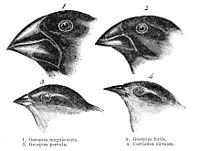
Photo from wikipedia
Phenological shifts in plant species are one of the most conspicuous signs of climate change impact on the biosphere. Modeling phenological variations of plant species over broad regions is challenging… Click to show full abstract
Phenological shifts in plant species are one of the most conspicuous signs of climate change impact on the biosphere. Modeling phenological variations of plant species over broad regions is challenging because of the varied climatic requirements of geographic populations due to local adaptation. In this study, we developed an empirical method to calibrate phenological models of temperate trees using latitude as a predictor to account for local adaptation of populations to a N–S temperature gradient. Fourteen widely distributed tree species in the eastern U.S.A. were investigated using data from the USA-National Phenology Network. We implemented the method in a basic thermal time bud break model to introduce the algorithm of the method and test its effectiveness. For each species, dates of breaking leaf buds were first predicted using a traditional non-spatial model and then with a spatial model that has the critical thermal forcing requirements calibrated for different populations at varied latitudes. As anticipated, non-spatial model predictions that assumed a uniform forcing requirement across latitudes showed consistent and systematic biases at both higher (overestimation-predictions being later) and lower (underestimation-predictions being earlier) latitudes. Spatial models that have been calibrated using our method removed the geographic biases and yielded latitudinal gradients that more closely matched those of the observations. The spatial models also reduced the overall prediction errors from an average root mean square error (RMSE) of 32.2 days to 20.4 days for the training dataset and an average root mean square error for prediction (RMSEP) of 32.2 days to 19.9 days for the testing dataset. This paper is focused on introducing the new calibration method as a preparatory step toward developing operational models that may potentially predict large-scale and range-wide phenological responses of various plant species to climatic changes with improved local accuracy.
Journal Title: International Journal of Biometeorology
Year Published: 2021
Link to full text (if available)
Share on Social Media: Sign Up to like & get
recommendations!